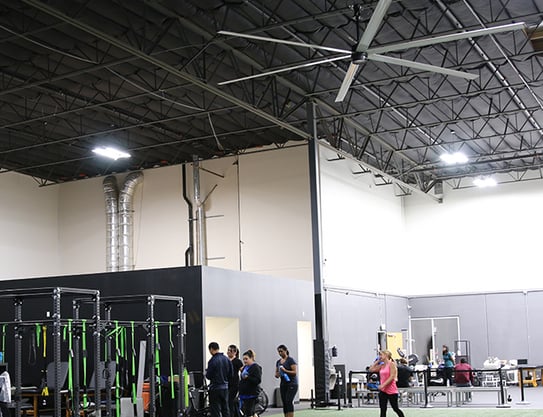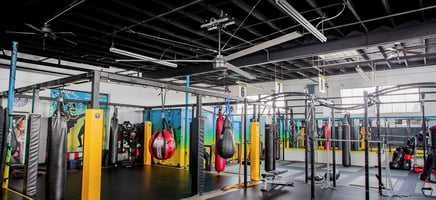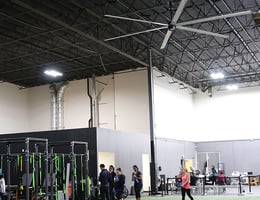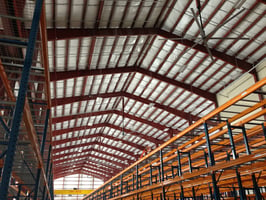“How can I keep my gym cool and comfortable while still keeping my budget in check?” We all know...
Gym Ventilation Requirements
As a gym owner, it is essential to understand the importance of proper ventilation in your facility. Adequate ventilation is necessary to ensure the health and safety of your staff and members, as well as to protect your equipment and building. In this blog, we will explore the various gym ventilation requirements that must be met in order to keep people safe and healthy. We will also provide an overview of the codes and standards that apply to gym ventilation, as well as information on how to measure and improve ventilation in your gym.
Table of Contents
The Importance of Good Ventilation
Gym Ventilation Codes and Standards
Measuring Ventilation and Air Quality
How to Improve Gym Ventilation
Impact of Proper Gym Ventilation
Importance of Good Ventilation
Proper ventilation is essential for maintaining the health and safety of your staff and members. Adequate ventilation helps to remove pollutants and moisture from the air, which can lead to mold growth and other indoor air quality issues. Additionally, good ventilation helps to keep your equipment and building in good condition by removing moisture and reducing the build-up of dust and other particles.
The Effects of Poor Ventilation
Physical Health
Proper gym ventilation is essential for maintaining physical health and well-being. Poor ventilation can lead to a variety of health problems, including headaches, respiratory issues, and allergies. In addition, poor ventilation can also lead to an increased risk of mold growth, which can cause even more serious health problems.
Mental Health
Proper ventilation is also important for maintaining mental health and well-being. Poor ventilation can lead to a variety of mental health problems, including anxiety, depression, and stress.
Athletic Performance
Proper ventilation is also important for maintaining athletic performance. Poor ventilation can lead to a variety of athletic performance problems, including fatigue, injury, and decreased endurance.
In addition, poor ventilation can also have an impact on the spread of infectious diseases, such as COVID-19.
Gym owners have a duty to make sure their facility has adequate ventilation in order to provide a safe and healthy environment for their staff and members. Being aware of the set state and local standards is crucial.
Gym Ventilation Codes and Standards
Gym ventilation is governed by a variety of codes and standards. Gym owners should be familiar with these requirements to make sure they are in compliance and keeping their facility safe and healthy.
OSHA Gym Regulations
The Occupational Safety and Health Administration (OSHA) has specific guidelines for gym ventilation. These guidelines include requirements for air temperature, air flow, and air intake flow rate. OSHA requires that gyms have a minimum ventilation rate of 20 cubic feet per minute per person.
OSHA's general guidelines for ventilation in indoor workplaces include the following:
- Ensure that the air is free of hazardous concentrations of contaminants: This includes contaminants such as chemicals, fumes, dust, and biological agents.
- Provide enough fresh air to prevent the buildup of indoor air pollutants: This can be achieved through natural or mechanical ventilation systems.
- Maintain temperature and humidity levels that are comfortable for workers: This can help prevent heat stress and other comfort-related issues.
- Use local exhaust systems to control emissions from specific sources: This can include using hoods or enclosures to capture fumes or dusts at the source.
- Use air cleaning systems to remove contaminants from the air: This can include using filters, electrostatic precipitators, or other types of air cleaners.
- Regularly inspect and maintain ventilation systems to ensure they are working properly: This includes cleaning ductwork, replacing filters, and checking for leaks.
- Consult with experts to determine appropriate ventilation requirements for specific workplaces. This helps to make sure ventilation systems are properly designed and installed to meet the specific needs of the workplace.
Gym ventilation requirements do vary depending on the location and the specifics of the facility. We recommend consulting the state and local building codes and regulations along with experts to ensure compliance and safety.
Measuring Ventilation and Air Quality
In order to ensure that your gym meets the necessary ventilation requirements, it is important to regularly measure and test the air quality in your facility. This can be done using a variety of tools, such as air quality monitors and ventilation testing equipment. These can be found online. Do your research to find the one that best suits your facility type.
How To Improve Gym Ventilation
.jpg?width=559&height=419&name=UFC_Kendall_Gym_AVD3_5%20(1).jpg)
There are a number of ways to improve the ventilation in your gym. These include natural ventilation, HVAC maintenance and HEPA filters, air intakes and exhaust, outdoor air quality, moisture control, and ceiling fans.
Natural Ventilation
Natural ventilation is a great way to improve the air quality in your gym. This can be done by opening doors and windows to allow fresh air to enter the building. This is not always possible due to weather, location, or other factors.
HVAC Maintenance and HEPA Filters
Regular maintenance of your HVAC system is essential for ensuring proper ventilation in your gym. This includes cleaning and replacing air filters, which should have a dust-spot rating between 35% and 80% or a Minimum Efficiency Rating Value (MERV) of between 8 and 13.
Air Intakes and Exhaust
Properly functioning air intakes and exhaust fans help ensure adequate ventilation in your gym. These systems help to remove stale air and bring in fresh air, which can help to improve indoor air quality and reduce the risk of mold growth.
Outdoor Air Quality
The air quality outside your gym can also have an impact on indoor air quality. It is important to monitor and address any potential pollution sources in the surrounding area, such as heavy traffic, industrial facilities, or other environmental issues.
Moisture
High humidity levels can lead to moisture issues. This can lead to mold growth and other indoor air quality issues. Address any sources of moisture quickly, such as leaks or high levels of humidity, and use dehumidifiers or other moisture control measures as needed. HVLS ceiling fans can help drastically cut the moisture content and humidity levels in the air.
Ceiling Fans
Ceiling fans will greatly improve your air quality. In fact, large ceiling fans will help you achieve Indoor Air Quality (IAQ) standards, which in turn improves health, comfort, and performance.
There is a greater need than ever for gyms to keep their air quality clean and healthy for employees and members. Large ceiling fans, known as high volume low speed fans (HVLS fans) offer an effective solution to ventilation issues your gym may have.
MacroAir HVLS ceiling fans are extremely high quality fans. They range in size from 6-24 feet in diameter. They work to circulate the air in the room down and out. Air will be constantly moving throughout the entire space which will increase natural ventilation and create a healthier space.
Impact of Proper Gym Ventilation

Proper ventilation in a gym has a positive impact on various aspects of health and well-being, as well as the equipment and building. It helps to remove pollutants and moisture from the air. This can result in a healthier and more comfortable environment for the staff and members. Adequate ventilation can help to prevent a variety of indoor air quality issues, such as mold growth, reduced air quality, unpleasant odors, and reduced airflow.
Physical Health
Adequate ventilation can help to prevent a variety of health problems, such as headaches, respiratory issues, allergies, and other physical symptoms associated with poor indoor air quality. Proper ventilation also helps to reduce the risk of mold growth, which can cause serious health problems.
Mental Health
Adequate ventilation can help to prevent a variety of mental health issues, such as anxiety, depression, stress, and other psychological symptoms associated with poor indoor air quality.
Athletic Performance
Proper ventilation helps to maintain the right temperature, humidity, and airflow in the gym, which can help to improve athletic performance. This can result in increased endurance, reduced risk of injury, and better overall performance for the athletes. Proper ventilation also helps to reduce the spread of infectious diseases, such as COVID-19, which can impact the performance of athletes.
Ceiling Fans for Enhanced Gym Ventilation
.png?width=219&height=219&name=gym-02-R0%20(2).png)
When it comes to improving gym ventilation, the Lincoln Street residential fan by MacroAir stands out as an exceptional choice. Though initially designed for residential use, its performance, durability, and design make it an ideal addition to fitness environments that need efficient airflow and ventilation on a smaller scale.
The Lincoln Street fan, with its reverse operation feature, ensures year-round comfort by distributing air evenly throughout the space. Available in 62", 72", and 84" diameters, this fan not only keeps gym-goers cool but also helps reduce moisture and prevents the buildup of stale air, which can lead to humidity issues and mold growth. For a gym, this means maintaining a healthier atmosphere where members can work out comfortably and safely.
Additionally, the sleek and quiet design of the Lincoln Street fan makes it perfect for gyms that prioritize a calm, distraction-free environment. Whether used in a commercial setting or a home fitness room, it enhances air quality without the overwhelming noise typically associated with larger ventilation systems.
By installing the Lincoln Street fan, gym owners can promote better air circulation, reduce energy costs, and ensure a more pleasant workout experience for their members.
Bottom Line
Proper ventilation is essential for maintaining the health and safety of your staff and members, as well as protecting your equipment and building. Gym owners should be familiar with the various gym ventilation requirements and codes, and take steps to ensure compliance and improve ventilation in their facility. This may include implementing natural ventilation, maintaining HVAC systems and using HEPA filters, properly functioning air intake and exhaust systems, and monitoring outdoor air quality and moisture control. By following these guidelines, gym owners can ensure that their facility has adequate ventilation and provide a safe and healthy environment for their staff and members.
We at MacroAir work hard to improve ventilation within your fitness facilities with our HVLS ceiling fans. MacroAir fans offer a very simple and cost-effective solution to reduce your energy bills and address your gym's ventilation needs. They will leave your customers feeling far more comfortable and breathing much easier as they work out.
Please download the quick reference guide on common ventilation requirements below.
Frequently Asked Questions
What are the ventilation requirements for a given space?
The ventilation requirements for a given space will depend on the specific use of the space, as well as local building codes and regulations. Generally, ventilation systems are designed to provide a specified amount of fresh air to the space in order to maintain healthy indoor air quality and to remove pollutants and excess moisture. Factors such as the size of the space, the number of people occupying the space, and the types of activities taking place in the space will all play a role in determining the appropriate ventilation requirements. Some common types of ventilation systems include natural ventilation, mechanical ventilation, and hybrid ventilation systems.
How do you ventilate an exercise room?
To ventilate an exercise room, one can use natural ventilation (using windows/doors), mechanical ventilation (using fans/ducts) or hybrid ventilation (combining natural and mechanical methods). It's important to consult with an HVAC expert and comply with local building codes. Additionally, exhausts should be used to remove moisture and pollutants generated by activities and equipment.
What are the requirements of good ventilation system in building?
A good ventilation system in a building should have: Adequate airflow, proper air distribution, filtration, temperature control, moisture control, energy efficiency, noise control, easy maintenance and compliance with local building codes and standards.
How many cfm of air ventilation is required per person in an office space?
The required ventilation rate per person in an office space varies depending on the local building codes and standards, and also on the type of office space. However, a common ventilation rate is around 20-40 cubic feet per minute (cfm) per person. This is a general guideline, the specific requirement may differ based on the type of office, the number of people in the office, the size of the office, and the activity level of the occupants.
It is important to consult with a HVAC expert and comply with the regulations and standards of the local building codes in order to determine the appropriate ventilation rate for a specific office space.
What is the minimum number of ventilation acceptable in a workplace?
The minimum number of ventilation required in a workplace varies depending on local building codes, standards, and the type of workplace. It's important to consult with a HVAC expert and comply with local regulations and standards to determine the appropriate ventilation rate. For example, OSHA in the US require workplaces to have a "reasonable" and "adequate" supply of fresh air and ASHRAE recommends a minimum of 20 cfm per person for office spaces and 30 cfm per person for high occupancy spaces. However, these are general guidelines, specific minimum requirements may vary.
How do I ventilate my garage gym?
To ventilate a garage gym, you can:
- Add an HVLS ceiling fan.
- Open windows and doors to allow fresh air in and stale air out.
- Install a mechanical ventilation system like an exhaust fan.
- Use a portable air purifier to remove pollutants and odors.
- Use a dehumidifier to remove excess moisture.
- Insulate the garage to reduce heat transfer and ventilation needed.
- Keep windows covered during the day to prevent heat from entering.
It's important to consult with a HVAC expert to determine the appropriate ventilation solution and comply with local building codes and standards.
Should a gym be air conditioned?
Yes, a gym should be air conditioned. Proper ventilation and temperature control are important for the comfort and safety of gym-goers, as well as for the preservation of equipment and materials. Air conditioning also helps to prevent the buildup of heat and humidity, which can be conducive to the growth of bacteria and other microorganisms.
Should a home gym have a window?
A home gym does not necessarily need a window, but it can be beneficial to have one. Windows can provide natural light, which can make the gym feel more open and inviting. They can also provide fresh air and a view, which can make the workout experience more pleasant. However, having a window also depends on personal preference and the available space in the room. If the room is small and windowless, you can have a good workout as well.
What are the 4 types of ventilation?
The 4 types of ventilation are natural, mechanical, balanced and spot. Natural ventilation relies on natural forces, mechanical uses fans and ducts, balanced combines both natural and mechanical and spot ventilation is used to control air quality in specific areas of a building.
What is the maximum allowed distance between ventilation openings?
The maximum allowed distance between ventilation openings can vary depending on the building code and regulations of your location. It's typically determined by the size of the room and the number of occupants. The International Residential Code (IRC) and the International Building Code (IBC) are common codes that set guidelines for ventilation in residential and commercial buildings, but the specific regulations regarding distance between ventilation openings can vary. It's best to consult with a local building inspector or code official to determine the specific requirements for your location.
How do you design ventilation?
Designing ventilation involves conducting a site assessment, establishing ventilation rates, choosing the appropriate ventilation system, designing and installing the system, and performing regular maintenance. It's best to consult with a professional engineer or architect to ensure proper design and implementation.
How to Ensure a Well-Ventilated and Safe Gym?
To ensure a well-ventilated and safe gym, it is important to: properly size and install the ventilation system, regularly maintain the system, ventilate the gym during classes and activities, ventilate specific areas, implement good hygiene practices, monitor Indoor Air Quality (IAQ), and follow guidelines and regulations.




